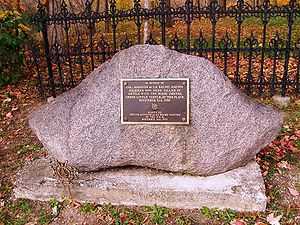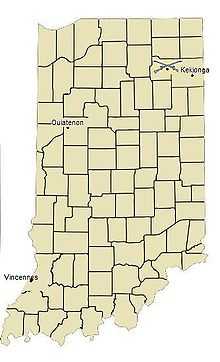Augustin de La Balme
| La Balme's Defeat. | |||||||
|---|---|---|---|---|---|---|---|
| Part of American Revolutionary War | |||||||
 DAR LaBalme Defeat Historical Marker on Dela Balme Road in Whitley County, Indiana | |||||||
| |||||||
| Belligerents | |||||||
| Miami tribe | Canadien colonial militia | ||||||
| Commanders and leaders | |||||||
| Little Turtle | Augustin de La Balme † | ||||||
| Strength | |||||||
| ? | 104 | ||||||
| Casualties and losses | |||||||
| 5 killed[1] | 30-40 killed | ||||||
Augustin Mottin de la Balme was a French cavalry officer who served in Europe during the Seven Years' War and in the United States during the American Revolution. His attempt to capture Fort Detroit in 1780 ended in defeat when he was ambushed by forces under Chief Little Turtle.
Seven Years' War
Augustin Mottin was born 28 August 1733, in the French Alps near Saint-Antoine, the son of a tanner. He served as a trooper in the distinguished “Scottish” company of the Gendarmerie de France during the Seven Years' War. He was one of the French cavalry officers who survived the crushing defeat at the Battle of Minden.
Following the war, Augustin studied horsemanship, eventually becoming master at the Gendarmerie’s Riding School in Lunéville. Mottin was promoted to Fourrier-Major in 1766, and retired with a pension in 1773. Using the assumed name “Mottin de La Balme,” he wrote a book on horsemanship in 1773, titled Essai sur l’équitation ou principes raisonnés sur l’Art de monter et de dresser les chevaux.[2] He followed with a book on cavalry tactics in 1776.
American Revolution

Augustin de La Balme left for the United States to assist in the American Revolution. In 1777, he was appointed as the Colonial Army’s Inspector General of Cavalry.[3] Upon learning that Casimir Pulaski would be in command of the United States Cavalry, La Balme resigned in October 1777[4]
In 1780, allegedly under secret orders from General Washington, but as likely acting on his own, he traveled down the Ohio River to Kaskaskia. The success of General Clark’s capture of Fort Sackville at Vincennes inspired La Balme to attempt a similar feat against the British at Fort Detroit. La Balme arrived in Kaskaskia as a French officer and was "greeted as Masiah" by the local Canadien residents, who had been living under British rule for over a decade. He gathered a list of grievances from residents living under the rule of the Virginians, which was to be delivered to the French Ambassador at Fort Pitt.[5] La Balme coordinated a diversionary attack against Fort St. Joseph,[6] then began his journey to Detroit, recruiting militia from among the Canadian citizens of Kaskaskia, Cahokia, and Vincennes. At Vincennes, he started up the Wabash River with the expectation of adding to his force from the Canadian villages of Ouiatenon (present day West Lafayette, Indiana) and Kekionga (present day Fort Wayne). La Balme apparently expected Canadian residents at Fort Detroit to join him as well, once they arrived. The expedition marched under a French flag.[7]
La Balme's force had little opposition until reaching Kekionga, where La Balme had planned to arrest Charles Beaubien, the British agent. Beaubien and many of the Miami were not there, however, so the force raised the French flag[8] and raided British stores for over three days while awaiting reinforcements that never arrived. Upon learning of the return of a Miami hunting party to Kekionga, Le Balme departed to raid another trading post on the Eel River. Leaving some twenty men to guard the captured stores at Kekionga, his force marched out over the Eel River trail (the same trail Colonel John Hardin would follow ten years later).
The Miami Indians, learning of the intrusion, destroyed the small group of men left at Kekionga. Chief Little Turtle, who lived in a village along the Eel River, attacked La Balme before he reached the Eel River trading post. La Balme and his men fortified themselves on the banks of the river. There remains some confusion as to the length of the battle; accounts of the siege vary from several days to several weeks. They were eventually defeated by an overwhelming force, and only a few survivors managed to escape. Augustin de la Balme died in the battle, which became known as La Balme's Defeat.
Aftermath

- For his leadership in this battle, Little Turtle gained a reputation that initiated a successful career as a war chief.
- Although LaBalme’s expedition resulted in failure, it did cause the British considerable concern. Major de Peyster subsequently deployed a detachment of British Rangers to protect Kekionga.
- Fort Detroit would remain under British control until the Jay Treaty was ratified in 1796. (Detroit was again surrendered to the British in the War of 1812, but was returned at the conclusion of the war.) In a log entry dated 13 November, Major Arent DePeyster, in command of the British garrison at Detroit, recorded:
"A detachment of Canadians from the Illinois and Post Vincennes arrived Kekionga about 10 days ago, and entered the village, took the horses, destroyed the horned cattle and plundered a store I allowed to be kept there for the convenience of the Indians, soon after assembled and attacked the Canadians, led by a French colonel."
"… The Miami resisting the fire of the enemy, had five of their party killed, being, however, more resolute than savages are in general, they beat off the enemy, killed 30 and took LaBalme prisoner with his papers ... I expect the Colonel in every hour …” [9]
- The Spanish Governor at St. Louis, Francisco Cruzat, wrote
"… I am very sorry for what has happened to Monsieur LaBalme ... [he] having, perhaps, attempted with imprudence an undertaking which needed more time, more strength and better circumstances ... "
Memorials

- In northeast Indiana, near the Allen – Whitley County line, along the Eel River, A brass and stone marker placed by the Daughters of the American Revolution in 1930, reads: "In memory of Col. Augustin de La Balme and his soldiers who were killed in battle with the Miami Indians under Little Turtle at this place, November 5, 1780."
- 5 November 2005, the Indiana Society Sons of the American Revolution erected a bronze marker and commemorated the event's 225th anniversary. The ceremony involved descendents of Revolutionary War soldiers and Miami Indians.
- 6 November 2010, the Indiana Society Sons of the American Revolution erected a bronze historical marker commemorating the event.
References
Notes
- ↑ Griswold, Bert Joseph; Taylor, Mrs. Samuel R. (1917). The pictorial history of Fort Wayne, Indiana: a review of two centuries of occupation of the region about the head of the Maumee River 1. Robert O. Law Co. p. 78. Retrieved 12 February 2011.
- ↑ Ryerson, 830
- ↑ Allison, 45
- ↑ See letter of John Hancock to George Washington, 12 Oct 1777. Available online at the Library of Congress.
- ↑ English, V2, pg 695
- ↑ Allison, 49
- ↑ Seineke, pg 36, fn
- ↑ Barnhill, John (2006). "Mottin de La Balme, Augustin (1740–1780)". In Richard Alan Ryerson, Gregory Fremont-Barnes. The Encyclopedia of the American Revolutionary War: A Political, Social, and Military History. Santa Barbara, CA: ABC-CLIO.
- ↑ Major DePeyster believed Colonel de LaBalme had been captured alive.
Sources
- Allison, Harold (1986). The Tragic Saga of the Indiana Indians. Turner Publishing Company, Paducah. ISBN 0-938021-07-9.
- Birzer, Bradley J. (Summer 2000). "French Imperial remnants on the middle ground: The strange case of August de la Balme and Charles Beaubien" (PDF). Journal of the Illinois State Historical Society. Retrieved 5 December 2011.
- Carter, Harvey Lewis (1987). The Life and Times of Little Turtle: First Sagamore of the Wabash. Urbana: University of Illinois Press. ISBN 0-252-01318-2.
- English, William Hayden (1896). Conquest of the Country Northwest of the River Ohio 1778-1783 and Life of Gen. George Rogers Clark, Vol I. The Bowen-Merrill Company. Indianapolis, Ind., and Kansas City, Mo.
- Magnin, Frédéric (2005). Mottin de la Balme, cavalier des deux mondes et de la liberté. L'Harmattan, Paris. ISBN 2-7475-9080-1.
- Ryerson, Richard Alan; Fremont-Barnes, Gregory (2009). "Mottin de La Balme, Augustin (1740-1780)". The Encyclopedia of the American Revolutionary War: A Political, Social, and Military History. Santa Barbara, CA: ABC-CLIO. Retrieved 20 November 2010.
- Seineke, Kathrine Wagner (1981). George Rogers Clark: Adventure in the Illinois and Selected Documents of the American Revolution at the Frontier Posts. Polyanthos. ISBN 99920-1-653-1.
External links
- The Whitley County Historical Society - LaBalme
- LaBalme History - Sons of the American Revolution
- History of Ft. Wayne
- Augustin La Balme's letter to Benjamin Franklin
- A letter from Gen. Washington to LaBalme
- Mottin de La Balme
|